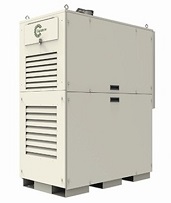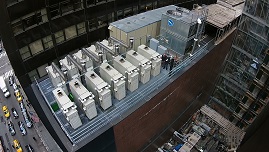 NATIONAL REPORT—An airplane turbine in your hotel? Not quite but the microturbines now being installed in hotels around the globe are smaller versions of an airplane turbine. Microturbines are reliable cores of combined cooling, heating, and power (CCHP) systems, generate one-tenth the emissions of an internal combustion engine, and are helping hotels save big time in energy and dollars.
NATIONAL REPORT—An airplane turbine in your hotel? Not quite but the microturbines now being installed in hotels around the globe are smaller versions of an airplane turbine. Microturbines are reliable cores of combined cooling, heating, and power (CCHP) systems, generate one-tenth the emissions of an internal combustion engine, and are helping hotels save big time in energy and dollars.
Darren Jamison, CEO of Capstone Turbine, a leading manufacturer of microturbines, says a microturbine is like a power plant in a box. “The efficiency comes from how the combustion is processed,” he says. Microturbines are highly efficient, quiet, require no oil or antifreeze, and can run on a variety of gaseous or liquid fuels.
“Hotels are great opportunities because they are operating 24/7,” Jamison says. “They have thermal loads that are steady. We are making hot water for the kitchen, laundry, swimming pool and other needs [such as space heating]. Using an absorption chiller we can make chilled water for air-conditioning.”
Jamison says microturbines are sized to the building they are in and intended to run 24/7. Capstone Turbine makes microturbines that can generate up to 30 MW of power when run parallel with one another. Microturbines are designed to run parallel with one another and parallel with the grid. They can also run independent of the grid. When asked what size hotel is the best fit for a microturbine, Jamison said 80 rooms or above.
Reasonable Payback Time
 Hoteliers can expect paybacks of four to five years for their investments. Incentives and tax credits can significantly reduce upfront cost for the systems that can run for 20 years. There is a 10 percent tax credit available at the federal level. PG&E in California, for example, has a Self-Generation Incentive Program for microturbines. The Lotte New York Palace received $1.5 million from NYSERDA for its microturbines.
Hoteliers can expect paybacks of four to five years for their investments. Incentives and tax credits can significantly reduce upfront cost for the systems that can run for 20 years. There is a 10 percent tax credit available at the federal level. PG&E in California, for example, has a Self-Generation Incentive Program for microturbines. The Lotte New York Palace received $1.5 million from NYSERDA for its microturbines.
The Ritz-Carlton San Francisco is saving about $120,000 a year by using four microturbines. Since installing the microturbines, the hotel has reduced its power consumption by 20 percent and emits 40 percent less CO2.
The Logan in Philadelphia also has benefitted from microturbines—in their case, three. In just the first two months of using the technology that was implemented in 2009, it saved $80,000. The technology now provides 100 percent of the hotel’s domestic water needs. “We reduced our energy costs by 30 percent,” says Marvin Dixon, V.P. of Engineering at Valley Forge Casino Resort, who worked with Capstone Turbine on the installation at the Four Seasons Hotel Philadelphia (now The Logan) at the time. The microturbines, which are located above the Presidential Suite, meet 20 percent of the hotel’s electricity needs and 75 percent of the building’s heating needs, Dixon says. The Logan reconfigured its hydronic heating loop into a system that captures heat from the microturbines and distributes it throughout the building. Before installing the microturbines, the hotel relied heavily on the city of Philadelphia’s steam loop and the local electric grid to meet its energy needs. A rebate of $148,000 from the local utility helped fund the microturbines.
Jamison says microturbines are becoming increasingly more common in hotels as utility costs rise and the cost of natural gas, which microturbines run on, remains low. “It is a good market,” he says. “We have been growing property by property. Architects and engineers are beginning to spec them in. They contribute to LEED certification.”
Glenn Hasek can be reached at editor@greenlodgingnews.com.





